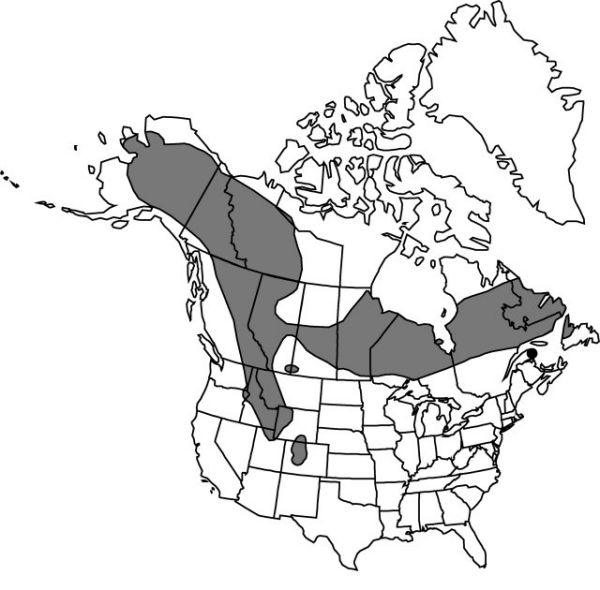Listera borealis
Bull. Torrey Bot. Club 20: 31. 1893.
Plants 4–26 cm. Stems green, slender to stout, slightly 4-angled, succulent, glabrous. Leaves: blade green to dark bluish green, elliptic, ovate-elliptic, or lanceolate, 1.3–6 × 0.7–3 cm, apex obtuse to rounded. Inflorescences 5–20-flowered, lax, 20–90 mm; floral bracts lanceolate, ovate, or oblong, 1–3 × 0.5–1 mm, apex obtuse; peduncle and rachis glandular-pubescent. Flowers pale green, yellowish green, or bluish green with veins darker green; pedicel filiform, 3.5–7 mm, glandular-pubescent; sepals and petals strongly reflexed away from lip and column; dorsal sepal elliptic-lanceolate to linear-elliptic, 4–6 × 1.5–2.2 mm, apex obtuse to rounded; lateral sepals linear-elliptic to oblong-lanceolate, falcate, 4.5–7 × 1.4–2.3 mm, apex obtuse to rounded; petals linear to linear-oblong, falcate, 4.5–5 × 0.7–1.5 mm, apex obtuse; lip oblong, slightly narrowed in center, base with broadly rounded and bluntly angled divergent auricles, apex slightly dilated, cleft into 2 oblong or semiorbiculate lobes, with apicule in sinus; disc 3-veined, lateral veins branched and purplish, base darker green, with ridge in center, thickened along center, 7–12 × 4.2–6.5 mm, margins ciliate; column arcuate, stout, 3–4 × 1 mm. Capsules ellipsoid, 8 × 5 mm. 2n = 56.
Phenology: Flowering Jun–Aug.
Habitat: In moist, rich humus of mossy coniferous or mixed hardwood forests, swamps, often along cold streams fed by melting snow, prefers high acidic soils
Elevation: 1500–3000 m
Distribution

Alta., B.C., Man., Nfld. and Labr., N.W.T., Nunavut, Ont., Que., Sask., Yukon, Alaska, Colo., Idaho, Mont., Oreg., Utah, Wash., Wyo.
Discussion
In Japan Listera borealis is replaced by L. yatabei Makino, which is nearly identical except for short basal auricles. Listera borealis and L. auriculata are very similar in overall appearance; the ovaries and pedicels in L. borealis are glandular-pubescent, and in L. auriculata they are glabrous.
Leaves occur three in a whorl in Listera borealis forma trifolia Lepage.
Selected References
None.